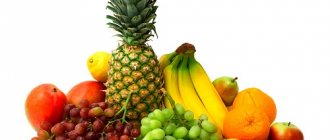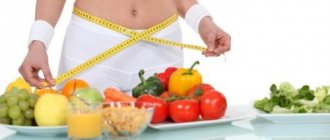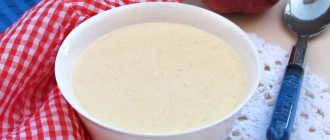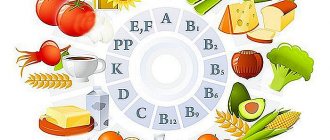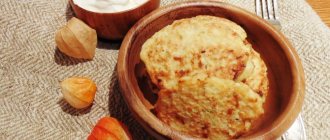Calorie content, glycemic index and glycemic load of vegetables and fruits
Calorie content is a very important, but far from the only indicator that needs to be taken into account when creating an individual diet.
Calorie content should be considered in conjunction with the glycemic index (GI) and glycemic load (GL).
The glycemic index is the rate at which blood sugar levels rise after eating a certain food. The lower the GI, the slower the blood sugar level rises after consuming the product. A high GI promotes the rapid production of insulin in large quantities, thanks to which you get a lot of energy and strength in a short period of time after eating. If you are waiting for an intense workout in the gym, then there is nothing wrong with eating a vegetable or fruit that has a high GI. If you rest passively, then the excess energy that is not useful to you will be converted and stored in the body in the form of fat deposits.
Glycemic load is an indicator that demonstrates the speed, intensity and duration of changes in blood sugar levels. Thanks to GN, you can understand which vegetables and fruits will keep your blood sugar levels down for the longest time so that you can exclude them from your diet.
The lower the level of the glycemic index and glycemic load, the fewer calories that enter the body will remain in it in the form of extra pounds and centimeters on the waist. Thus, people who are losing weight and leading a healthy lifestyle are not recommended to eat potatoes, because they not only contain a lot of calories, but also have a high GI, the level of which increases even more when cooked.
Sweet and ripe fruits contain more calories and sugar than slightly unripe fruits. Therefore, give preference to fruits that are not too sweet and slightly unripe, which contain a lot of dietary fiber (fiber) and little sugar.
After heat treatment, the rate of energy release from carbohydrates increases significantly, since dietary fiber is greatly destroyed during cooking. Because of this, complex carbohydrates are transformed into simple ones. The body has to spend much more energy processing complex carbohydrates, which saturate the body slowly and gradually, than processing simple carbohydrates. Therefore, eat as many vegetables and fruits as possible in their raw form.
You should not chop vegetables or fruits very finely, because the speed of their absorption by the body depends on the size of the chopped pieces. Dietary fiber, which slows down the breakdown of carbohydrates, is destroyed when crushed. Therefore, it is recommended to eat fruits and vegetables whole or cut into large pieces.
What determines the calorie content of fresh fruits?
Fruits have varying degrees of calorie content, which depends on the liquid and sugar content. For example, unlike fresh fruits, dried fruits have a higher number of calories. During the drying process, they begin to lose moisture, so they become a concentrated source of energy - raisins (1/4 cup) have the same number of calories as grapes (1 cup).
The caloric content of canned and frozen foods will also be different, depending on whether sugar or syrup was added during cooking. The lowest calorie content is found in fresh fruits; the greater the amount of liquid included in the fruit, the lower the number of calories. So how many calories are in a banana, apple, orange or grape? To determine dietary foods, you do not need to use a special table.
- CRM systems - what are they? Rating of the best customer relationship management systems and their implementation
- Greek fish in the oven
- Hipsters - who are they? History of youth subculture, clothes and hairstyles in hipster style with photos
Calorie table for vegetables and greens per 100 grams
| No. | Name of vegetable or herb | Number of calories per 100 g | Quantity of used / used per 100 g | GI | GN |
| 1. | Celery | 12 | 1⁄0 / 2 | 15 | 0,3 |
| 2. | Leaf salad | 14 | 1⁄0 / 2 | 10 | 0,3 |
| 3. | Cucumber | 15 | 1⁄0 / 2 | 15 | 0,3 |
| 4. | Chinese cabbage | 16 | 1⁄0 / 3 | 15 | 0,4 |
| 5. | Zucchini | 17 | 2⁄0 / 2 | 15 | 0,8 |
| 6. | Green onions | 19 | 1⁄0 / 5 | 15 | 1,1 |
| 7. | Zucchini | 19 | 1⁄0 / 5 | 15 | 0,8 |
| 8. | Radish | 20 | 1⁄0 / 3 | 15 | 0,5 |
| 9. | Asparagus | 20 | 2⁄0 / 3 | 15 | 0,6 |
| 10. | Spinach | 22 | 3⁄0 / 2 | 15 | 0,4 |
| 11. | Tomatoes | 23 | 1⁄0 / 4 | 30 | 1,3 |
| 12. | Eggplant | 24 | 1⁄0 / 7 | 20 | 1,1 |
| 13. | Bell pepper | 27 | 1⁄0 / 6 | 15 | 0,8 |
| 14. | Artichokes | 28 | 1⁄0 / 6 | 20 | 1,2 |
| 15. | White cabbage | 28 | 2⁄0 / 5 | 15 | 0,6 |
| 16. | Cauliflower | 28 | 0 / 0⁄5 | 15 | 0,6 |
| 17. | Pumpkin | 29 | 1⁄0 / 8 | 65 | 3,4 |
| 18. | Broccoli | 33 | 4⁄2 / 5 | 15 | 0,7 |
| 19. | Fresh carrots | 33 | 1⁄0 / 4 | 30 | 1,8 |
| 20. | Dill | 38 | 2⁄0 / 6 | 5 | 0,4 |
| 21. | Chilli | 40 | 2⁄0 / 10 | 15 | 1,2 |
| 22. | Beet | 40 | 2⁄0 / 9 | 30 | 2,7 |
| 23. | Bulb onions | 41 | 1⁄0 / 10 | 15 | 1,4 |
| 24. | Brussels sprouts | 43 | 5⁄0 / 8 | 15 | 0,9 |
| 25. | Parsley | 45 | 4⁄0 / 8 | 5 | 0,4 |
| 26. | Boiled potatoes | 80 | 2⁄0 / 18 | 65 | 10,9 |
| 27. | Ginger | 80 | 2⁄1 / 16 | 15 | 2,1 |
| 28. | Olives | 115 | 1⁄11 / 6 | 15 | 0,9 |
| 29. | Boiled corn | 123 | 4⁄2 / 24 | 70 | 15,7 |
| 30. | Garlic | 146 | 6⁄0 / 30 | 30 | 9 |
| 31. | Olives | 166 | 2⁄16 / 5 | 15 | 0,8 |
The benefits of vegetables and fruits for the human body
Most vegetables and fruits contain virtually no fat and consist of dietary fiber (fiber). Dietary fiber is necessary for the body to improve the functioning of the gastrointestinal tract, normalize and speed up metabolism. Fiber helps the body naturally remove waste, toxins and excess fluid.
Vegetables and fruits contain many vitamins (B vitamins, vitamin A, vitamin C, vitamin E, vitamin K, vitamin H, vitamin PP, etc.), minerals (magnesium, manganese, calcium, zinc, potassium, copper, selenium, fluorine, iron, molybdenum, iodine, vanadium, cobalt, phosphorus, etc.) and other substances beneficial to our body.
Preparation methods and calorie content
It is clear that fresh fruits have the lowest energy value, but in our area not everyone can afford them all year round. Therefore, methods of harvesting fruits that allow them to be preserved for a long time come to the rescue. The most common methods include:
- drying;
- freezing;
- canning.
Calorie content of fruits
The most useful processing method is drying the fruits. Grapes, peaches, apricots, apples, plums, cherries, and pears are best suited for drying. If stored properly, they can be eaten for a year.
Why drying is the most suitable option for harvesting fruits
| The advantages of this method | Disadvantages of this method |
| Nutrients are preserved. But this must be done at low temperatures, as many vitamins and microelements are sensitive to heat. For example, vitamin C will begin to break down at 50 degrees Celsius. Therefore, the ideal drying option is conventional drying in direct sunlight. | Low product yield and the need for a large amount of fresh fruit. For example, from one hundred grams of apples only 20 grams of dried slices are obtained. |
| The advantage of this method is that it preserves the maximum amount of vitamins, fiber and pectin. Pectin, by the way, is very useful for losing weight, as it removes toxins and fat cells from the gastrointestinal tract. | You also need to take into account the high calorie content of dried fruits, which is several times higher than the original energy value. For comparison: fresh bananas have 90 kcal per hundred grams, but dried fruits have 250 kcal. |
From the point of view of caloric content, the most acceptable way is to freeze fruit, since the indicator remains at the original level. Also, the cold retains the lion's share of vitamins, but the taste is slightly lost. Under the influence of sub-zero temperatures and further thawing, the cells change - the structure is disrupted, and the products no longer look so appetizing. You can freeze all the same fruits that are listed for drying. Plus berries are added to them:
- gooseberry;
- raspberries;
- strawberry;
- blueberry.
Proper freezing consists of several stages. First, the fruits need to be washed, dried, placed in plastic containers and placed in the freezer. There they should be at a temperature of minus 20 degrees. These frozen desserts can be stored for up to ten months.
Canning greatly affects the calorie content of foods, as fruits become either compote with a high sugar content or jam with even more glucose. And canned foods have the least benefit, since, for example, vitamin C is destroyed already in the first minutes of heat treatment. The average loss of vitamins during canning reaches 70%. But the average calorie content of canned fruit is 70 kcal per 100 g.
In more rare cases, fruits are candied to preserve them for a long time. But they are definitely not suitable for a diet, since 100 grams contain more than 215 kcal due to the abundance of sugar. They can only be used as decoration for desserts or rare delicacies.
Calorie table for fruits per 100 grams
| No. | Fruit name | Number of calories per 100 g | Quantity of used / used per 100 g | GI | GN |
| 1. | Lemon | 16 | 1⁄0 / 3 | 20 | 20,6 |
| 2. | Watermelon | 27 | 0 / 0⁄8 | 75 | 6,6 |
| 3. | Cranberry | 28 | 0 / 0⁄4 | 45 | 3,1 |
| 4. | Grapefruit | 29 | 1⁄0 / 10 | 25 | 2,4 |
| 5. | Strawberry | 30 | 1⁄0 / 7 | 25 | 2 |
| 6. | Strawberries | 30 | 1⁄0 / 7 | 25 | 2 |
| 7. | Mandarin | 33 | 1⁄0 / 8 | 30 | 3 |
| 8. | Cherry plum | 34 | 0 / 0⁄8 | 25 | 1,6 |
| 9. | Orange | 36 | 1⁄0 / 8 | 30 | 3 |
| 10. | Black currant | 36 | 1⁄0 / 7 | 15 | 1,1 |
| 11. | Melon | 38 | 0 / 0⁄7 | 65 | 4 |
| 12. | Red Ribes | 39 | 1⁄0 / 8 | 25 | 1,9 |
| 13. | Pear | 42 | 0 / 0⁄11 | 30 | 4 |
| 14. | Raspberries | 42 | 1⁄0 / 11 | 25 | 2,9 |
| 15. | Blackberry | 42 | 1⁄0 / 11 | 25 | 2,9 |
| 16. | Plum | 42 | 1⁄0 / 10 | 30 | 2,4 |
| 17. | Gooseberry | 43 | 1⁄0 / 12 | 25 | 4 |
| 18. | Blueberry | 44 | 1⁄0 / 11 | 25 | 6 |
| 19. | Apricot | 46 | 1⁄0 / 11 | 35 | 2,5 |
| 20. | Peach | 46 | 1⁄0 / 11 | 35 | 3,5 |
| 21. | Apple | 47 | 0 / 0⁄10 | 35 | 4 |
| 22. | Nectarine | 48 | 1⁄0 / 12 | 35 | 3 |
| 23. | Kiwi | 48 | 1⁄0 / 10 | 50 | 5,5 |
| 24. | A pineapple | 49 | 0 / 0⁄11 | 50 | 7 |
| 25. | Cherry | 52 | 1⁄0 / 12 | 25 | 2,8 |
| 26. | Cherries | 52 | 1⁄0 / 12 | 25 | 2,8 |
| 27. | Pomegranate | 52 | 1⁄0 / 14 | 33 | 6,5 |
| 28. | Persimmon | 53 | 0 / 0⁄17 | 50 | 8 |
| 29. | Grape | 65 | 1⁄0 / 17 | 45 | 6,8 |
| 30. | Mango | 67 | 0 / 0⁄12 | 50 | 7 |
| 31. | Banana | 89 | 2⁄0 / 22 | 55 | 11 |
| 32. | Avocado | 208 | 2⁄20 / 7 | 10 | 0,2 |
| 33. | Coconut | 380 | 3⁄34 / 30 | 45 | 2,8 |
Fruit desserts and drinks
These gifts of nature can also be the main components of numerous delicacies. Some of them do not have too high a calorie content, which allows you to enjoy them even during a diet. For example, fruit jelly is a wonderful and healthy dessert. It contains large amounts of the aforementioned pectin, as well as glycine. The latter is very useful for strengthening bone tissue and cartilage. It is indicated as a prevention against arthritis. At the same time, the calorie content of fruit jelly varies from 50 to 90 kcal per 100 grams. For example, cherry jelly has a calorie content of about 55 kcal, strawberry jelly will have about 70 kcal, and orange jelly will have 88 kcal.
Advice from nutritionist Irina Shilina Healthy eating is incompatible with strict dietary restrictions, malnutrition and prolonged fasting. Today there is no need to strive for abnormal thinness by depriving yourself of food! Pay attention to the latest weight loss techniques for 2020. Read more about healthy food and vitamins ->
Fruit preserves have a higher calorie content, but in reasonable quantities you can enjoy them to sweeten your life. And jam like raspberry is even recommended for colds, as it helps relieve sore throat and improves immunity. One hundred grams of raspberry jam contains about 106 kcal. But it is so sweet that few people can handle 100 g at a time. Strawberry jam has a lower calorie content - 92 kcal per 100 g.
How to use the calorie table correctly?
Let's look at the calorie table above using watermelon as an example, since it has the highest glycemic index: 75 units per 100 g of product. Does this indicate that people who lead a healthy lifestyle and are losing weight should not include watermelon in their diet?
Since watermelon consists almost entirely of water, it has a very low glycemic load (only 6.6 units). Therefore, you can safely eat 100–200 g of watermelon and not be afraid that it will negatively affect your figure. But you should not abuse this product, since 600 g of watermelon causes a glycemic load of 39.6 units.
See also: Table of carbohydrate content: fruits, vegetables, nuts, cereals, cereals
If you find an error, please select a piece of text and press Ctrl+Enter.
High calorie fruits
High calorie fruits are included in the diet to build muscle mass. This option is suitable in cases where small children have no appetite, and teenagers are “tired of everything”, but require a source of energy for a growing body. Below is a table of fruit calories per 100 grams, which displays the main types of fruits and their nutritional value.
| Type of fruit | Calorie content (kcal) | Properties |
| Dates | 275-281 | This is the highest calorie fruit. It has a positive effect on the heart, blood vessels, and digestive system. But it should still be consumed in moderation. |
| Avocado | 165-170 | This type is considered the most nutritious. It contains a high content of potassium and monounsaturated fatty acids. The properties of avocado fruits resemble fatty fish. It is suitable for preparing nutritious snacks and light salads |
| Banana | 85-90 | The healthy fruit contains an increased level of potassium and easily digestible sugars. It is recommended to use it when you need to quickly restore strength. Has a beneficial effect on the condition of the heart. The fruit does not provoke allergic reactions, and the amino acid tryptophan is converted in the body into the joy hormone serotonin. Despite its high calorie content, the fruit has a moderate glycemic index, so it can be included in the menu when losing weight |
| Mango | 65-68 | An exotic fruit with high nutritional value is of great benefit to the body. It protects against cancer processes and stops aging. It is a powerful antioxidant that prevents the development of atherosclerosis |
| Persimmon | 63-67 | It is of great benefit to all internal organs and systems of the body. The fruit contains tannins, which create an astringent effect. Has a positive effect on the heart and blood vessels. In dry form, the calorie content is 3-4 times higher |
| Figs | 55-59 | The fruit has a high content of fiber, vitamins, and antioxidants. It is useful for people who have heart problems. But in Russia it is more often found in dried form, so its calorie content must be multiplied by three |
| Papaya | 50-54 | The fruit contains a high level of papain, which breaks down proteins without any problems. It is beneficial to eat both fresh and frozen fruit. |
| Pomegranate | 49-52 | The fruit is recommended for consumption by people who have anemia and low hemoglobin levels. Has a positive effect on the functioning of the thyroid gland. Stops the development of tumors and infectious processes |
| Nectarine | 47-51 | This is a sweet variety of peach. The composition includes a high level of potassium, which is required for the heart and blood vessels. Vitamin B17 has a destructive effect on cancer cells. Other substances improve the functioning of the digestive system, cleanse and rejuvenate the skin, strengthen hair |
| Quince | 46-49 | It has a positive effect on the condition of the heart muscle, blood vessels, and improves the nervous system. Cleanses the body of toxins, helps with acute respiratory infections |
